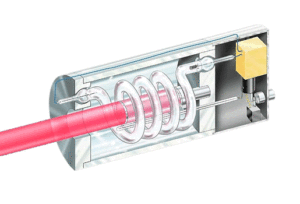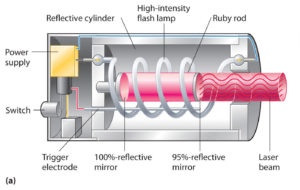Ruby Laser
Ruby belongs to the family of gems consisting of Al O with various types of impurities. For example
pink Ruby contains 0.05% Cr atoms.

Construction of Ruby Laser:
The ruby lazer consists of a ruby rod . which is made of chromium doped ruby material. At the
opposite ends of this rod there are two silver polished mirrors. Whose one is fully polished and other is
partially polished. A spring is attached to the rod with fully polished end for adjustment of wave length of the lazer light. Around the ruby rod a flash light is kept for the pump input. The whole assembly is
kept in the glass tube. Around the neck of the glass tube the R.F source and switching control is
designed in order to switch on and off the flash light for desired intervals.

Operation of Ruby Laser:
When we switch on the circuit the R.F operates. As a result the flash of light is obtained around the
ruby rod. this flash causes the electrons within ruby rod to move from lower energy band towards
higher energy band. The population inversion take place at high energy band and electrons starts
back to travel towards the lower energy band. During this movement the electron emits the laser light .
This emitted light travels between the two mirrors where cross reflection takes place of this light. The
stimulated lazer light now escapes from partially polished mirror in shape of laser beam.
The spring attached with the fully polished mirror is used to adjust the wave length equal to λ/2 of lazer
light for obtimum lazer beam. The switching control of the R.F source is used to switch on and off the
flash light so that excessive heat should not be generated due to very high frequency of the movement
of the electron.
Energy Level Diagram for Ruby Laser:

The above three level energy diagram show that in ruby lasers the absorption occurs in a rather broad
range in the green part of the spectrum. This makes raise the electrons from ground state E to the
band of level E higher than E . At E these excited levels are highly unstable and so the electrons
decays rapidly to the level of E . This transition occurs with energy difference (E – E ) given up as
heat (radiation less transmission). The level E is very important for stimulated emission process and
is known as Meta stable state. Electrons in this level have an average life time of about 5m.s before
they fall to ground state. After this the population inversion can be established between E and E .
The population inversion is obtained by optical pumping of the ruby rod with a flash lamp. A common
type of the flash lamp is a glass tube wrapped around the ruby rod and filled with xenon gas. When the
flash lamp intensity becomes large enough to create population inversion, then stimulated emission
from the Meta stable level to the ground level occurs which result in the laser output. Once the
population inversion begins, the Meta stable level is depopulated very quickly. Thus the laser output
consists of an intense spike lasting from a few Nano sec to μsec. after stimulated emission spike,
population inversion builds up again and a 2 spike results. This process continues as long as the
flash lamp intensity is enough to create the population inversion.
